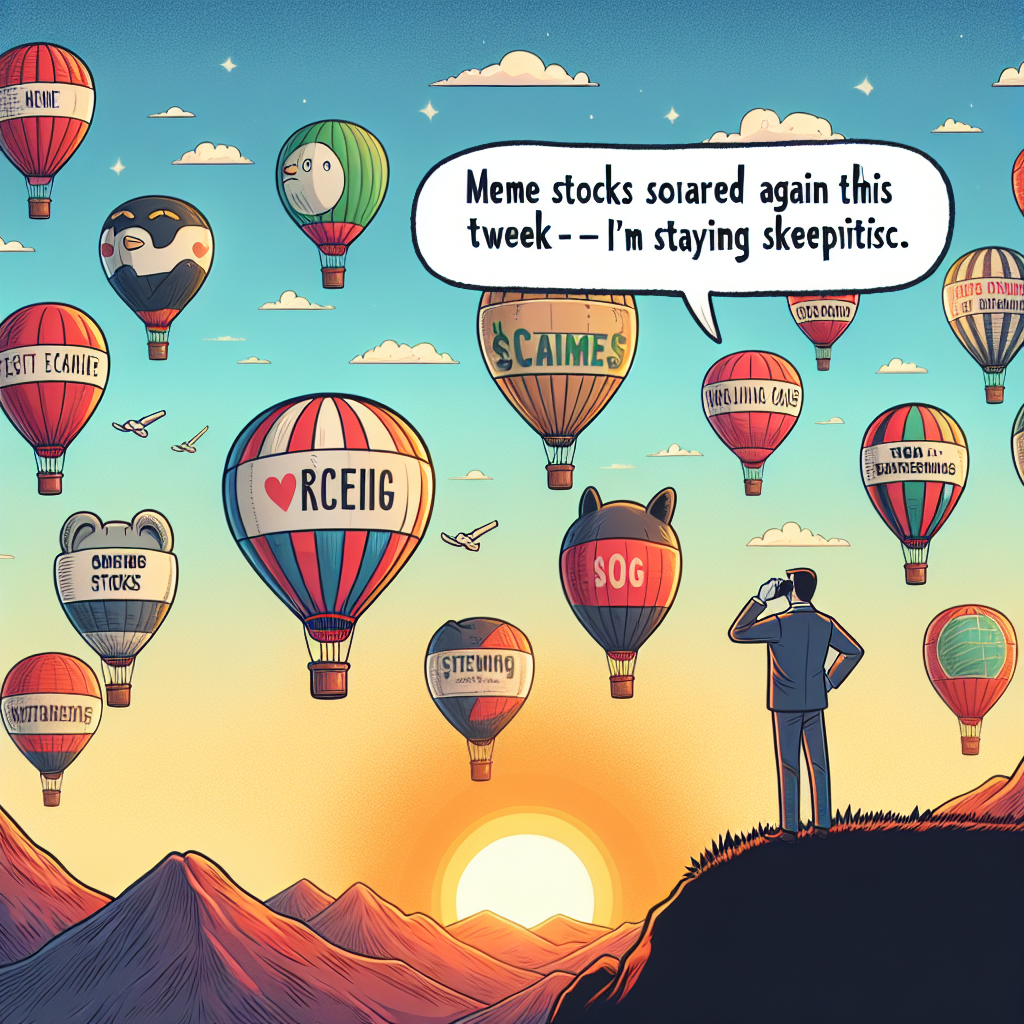-
Table of Contents
- Meme Stocks Soared Again This Week—But I’m Staying Skeptical
- Understanding Meme Stocks
- The Role of Social Media
- Key Characteristics of Meme Stocks
- Recent Trends in Meme Stocks
- GameStop (GME)
- AMC Entertainment (AMC)
- New Entrants
- Why I’m Staying Skeptical
- Fundamental Weaknesses
- Market Manipulation Concerns
- Volatility and Risk
- Short-Term Focus
- Case Studies: Lessons from the Past
- The Dot-Com Bubble
- The Housing Bubble
- Bitcoin and Cryptocurrency
- Strategies for Cautious Investors
- Diversification
- Focus on Fundamentals
- Long-Term Perspective
- Risk Management
- Conclusion
Meme Stocks Soared Again This Week—But I’m Staying Skeptical

The financial markets have been abuzz once again as meme stocks experienced another surge this week. These stocks, often driven by social media hype and retail investor enthusiasm, have captured the imagination of many. However, despite the excitement, I remain skeptical about their long-term viability. In this article, we will delve into the phenomenon of meme stocks, examine recent trends, and explore why caution is warranted.
Understanding Meme Stocks
Meme stocks are shares of companies that have gained popularity among retail investors through social media platforms like Reddit, Twitter, and TikTok. These stocks often experience rapid price increases due to coordinated buying efforts by online communities. The most famous examples include GameStop (GME) and AMC Entertainment (AMC), which saw unprecedented price surges in early 2021.
The Role of Social Media
Social media platforms have played a crucial role in the rise of meme stocks. Communities like Reddit’s WallStreetBets have become hubs for retail investors to share information, strategies, and rally behind specific stocks. The power of these communities lies in their ability to mobilize large numbers of investors quickly, creating significant buying pressure and driving up stock prices.
Key Characteristics of Meme Stocks
- High Volatility: Meme stocks are known for their extreme price swings, often experiencing double-digit percentage changes within a single trading day.
- Low Institutional Ownership: These stocks typically have low levels of institutional ownership, making them more susceptible to retail investor influence.
- Short Interest: Many meme stocks have high levels of short interest, meaning a significant portion of their shares are being bet against by institutional investors. This can lead to short squeezes, where short sellers are forced to buy back shares at higher prices, further driving up the stock price.
Recent Trends in Meme Stocks
This week, several meme stocks experienced notable price increases, reigniting interest in this market phenomenon. Let’s take a closer look at some of the key players and their recent performance.
GameStop (GME)
GameStop, the poster child of the meme stock movement, saw its stock price surge by over 20% this week. The company has been undergoing a transformation under the leadership of Ryan Cohen, co-founder of Chewy, who joined the board in early 2021. Despite these efforts, the company’s fundamentals remain questionable, with declining revenues and ongoing challenges in the retail sector.
AMC Entertainment (AMC)
AMC Entertainment, another prominent meme stock, also experienced a significant price increase this week, rising by more than 15%. The company has been leveraging its newfound popularity to raise capital and reduce debt. However, the long-term outlook for the movie theater industry remains uncertain, especially in the face of changing consumer preferences and the rise of streaming services.
New Entrants
In addition to established meme stocks like GameStop and AMC, several new entrants have emerged this week. Stocks like Clover Health (CLOV) and ContextLogic (WISH) have seen substantial price increases, driven by social media hype and retail investor enthusiasm. While these stocks may offer short-term gains, their long-term prospects are far from certain.
Why I’m Staying Skeptical
Despite the excitement surrounding meme stocks, there are several reasons why I remain skeptical about their long-term viability. Let’s explore some of the key concerns.
Fundamental Weaknesses
Many meme stocks have weak fundamentals, with declining revenues, high levels of debt, and uncertain business prospects. While social media hype can drive short-term price increases, it does not change the underlying financial health of these companies. Investing in stocks with poor fundamentals is inherently risky and can lead to significant losses.
Market Manipulation Concerns
The rapid price increases seen in meme stocks have raised concerns about market manipulation. Coordinated buying efforts by online communities can create artificial price inflation, leading to unsustainable valuations. Regulatory authorities, including the SEC, have expressed concerns about the potential for market manipulation and are closely monitoring these activities.
Volatility and Risk
Meme stocks are known for their extreme volatility, which can result in significant losses for investors. The rapid price swings make it difficult to predict future performance and can lead to emotional decision-making. For many retail investors, the risk associated with meme stocks may outweigh the potential rewards.
Short-Term Focus
The meme stock phenomenon is largely driven by short-term trading strategies, with many investors looking to capitalize on quick price increases. This short-term focus can lead to speculative bubbles and unsustainable valuations. Long-term investing, on the other hand, requires a focus on fundamentals and a commitment to holding stocks through market fluctuations.
Case Studies: Lessons from the Past
To better understand the risks associated with meme stocks, let’s examine some historical case studies of speculative bubbles and market manias.
The Dot-Com Bubble
The late 1990s saw the rise of the dot-com bubble, characterized by a surge in technology stock prices driven by investor enthusiasm for the internet. Many companies with little to no revenue saw their stock prices skyrocket, only to crash spectacularly when the bubble burst in 2000. The dot-com bubble serves as a cautionary tale about the dangers of investing in overhyped stocks with weak fundamentals.
The Housing Bubble
The mid-2000s housing bubble was fueled by speculative buying and easy credit, leading to a rapid increase in home prices. When the bubble burst in 2008, it triggered a global financial crisis and led to significant losses for investors. The housing bubble highlights the risks of speculative investing and the importance of understanding underlying market fundamentals.
Bitcoin and Cryptocurrency
The rise of Bitcoin and other cryptocurrencies has been marked by extreme volatility and speculative trading. While some investors have made significant gains, others have experienced substantial losses. The cryptocurrency market serves as a reminder of the risks associated with investing in highly speculative assets.
Strategies for Cautious Investors
For investors who are intrigued by the potential gains of meme stocks but wary of the risks, there are several strategies to consider.
Diversification
Diversification is a key principle of investing that involves spreading investments across different asset classes and sectors to reduce risk. By diversifying their portfolios, investors can mitigate the impact of losses in any single stock or sector. This approach can help protect against the volatility and risks associated with meme stocks.
Focus on Fundamentals
Investors should prioritize companies with strong fundamentals, including solid revenue growth, profitability, and manageable debt levels. By focusing on fundamentally sound companies, investors can reduce the risk of investing in overhyped stocks with weak financials.
Long-Term Perspective
Adopting a long-term perspective can help investors avoid the pitfalls of short-term trading and speculative bubbles. By focusing on long-term growth and holding investments through market fluctuations, investors can build wealth over time and reduce the impact of market volatility.
Risk Management
Effective risk management is essential for navigating the uncertainties of the stock market. Investors should set clear investment goals, establish risk tolerance levels, and use stop-loss orders to limit potential losses. By implementing risk management strategies, investors can protect their portfolios from significant downturns.
Conclusion
The recent surge in meme stocks has once again captured the attention of the financial markets. While the excitement and potential for quick gains are undeniable, it is essential to approach these investments with caution. The fundamental weaknesses, market manipulation concerns, and extreme volatility associated with meme stocks make them inherently risky. By focusing on diversification, fundamentals, a long-term perspective, and effective risk management, investors can navigate the challenges of the stock market and build a more resilient portfolio.
In summary, while meme stocks may offer short-term opportunities, their long-term viability remains uncertain. As an investor, it is crucial to remain skeptical and prioritize sound investment principles to achieve sustainable financial success.








